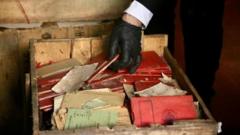Recent discoveries in Argentina's Supreme Court basement have brought to light crates filled with Nazi documents, shedding light on the country's historical ties to WWII.
Rediscovered Nazi Documents in Argentine Court: A Historical Revelation

Rediscovered Nazi Documents in Argentine Court: A Historical Revelation
Crates containing Nazi-era documents found in the basement of Argentina's Supreme Court reveal potential links to WWII propaganda and ideology.
The unexpected find of wooden crates in the basement of Argentina's Supreme Court has unveiled a collection of documents from Nazi Germany. These crates, which were originally sent from the German embassy in Tokyo in 1941, were discovered by workers clearing the space for archival relocation to a newly established museum. Upon examination, the documents were identified as materials meant to promote and consolidate Adolf Hitler's ideology within Argentina during World War II.
The crates arrived in Argentina on June 20, 1941, concealed within 83 diplomatic pouches aboard the Japanese steamship Nan-a-Maru. They were confiscated by Argentine customs officials who, suspicious of the shipment's contents due to its size, opened five random pouches and discovered Nazi propaganda, photographs, and membership booklets. Following this discovery, the Argentine government issued an order to seize all pouches and entrusted the Supreme Court with the next steps. However, it appears that a final decision on the documents was never made before 1944, when Argentina severed its ties with the Axis powers, resulting in the crates languishing in the court's basement for decades.
The recent rediscovery has piqued historians’ interest, who believe that these documents could provide valuable insights into the financial networks and international connections of Nazi operatives during the war. Upon being notified about the find, the Buenos Aires Holocaust Museum was engaged to assist in creating a comprehensive inventory of the contents. Experts have noted that the materials, which included photographs and various forms of propaganda, are emblematic of the influence of Nazi Germany in Argentina, especially in light of the country’s post-war history of providing refuge to numerous high-ranking Nazis including notorious figures like Adolf Eichmann and Josef Mengele.
In the context of Argentina's complex engagement with Nazi elements during and after the war, this discovery could reignite discussions around the historical narrative of the country’s role in harboring these figures. The Supreme Court's statement reflects a growing awareness and acknowledgment of this darker chapter in Argentina's history and may pave the way for further research into the implications of these documents on understanding the nation's wartime stance and subsequent actions.
The crates arrived in Argentina on June 20, 1941, concealed within 83 diplomatic pouches aboard the Japanese steamship Nan-a-Maru. They were confiscated by Argentine customs officials who, suspicious of the shipment's contents due to its size, opened five random pouches and discovered Nazi propaganda, photographs, and membership booklets. Following this discovery, the Argentine government issued an order to seize all pouches and entrusted the Supreme Court with the next steps. However, it appears that a final decision on the documents was never made before 1944, when Argentina severed its ties with the Axis powers, resulting in the crates languishing in the court's basement for decades.
The recent rediscovery has piqued historians’ interest, who believe that these documents could provide valuable insights into the financial networks and international connections of Nazi operatives during the war. Upon being notified about the find, the Buenos Aires Holocaust Museum was engaged to assist in creating a comprehensive inventory of the contents. Experts have noted that the materials, which included photographs and various forms of propaganda, are emblematic of the influence of Nazi Germany in Argentina, especially in light of the country’s post-war history of providing refuge to numerous high-ranking Nazis including notorious figures like Adolf Eichmann and Josef Mengele.
In the context of Argentina's complex engagement with Nazi elements during and after the war, this discovery could reignite discussions around the historical narrative of the country’s role in harboring these figures. The Supreme Court's statement reflects a growing awareness and acknowledgment of this darker chapter in Argentina's history and may pave the way for further research into the implications of these documents on understanding the nation's wartime stance and subsequent actions.

















